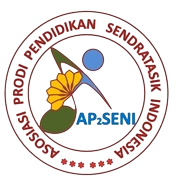Bentuk Penyajian Tari Atu Belah pada Masyarakat Gayo Kabupaten Aceh Tengah
Abstract
This research is the study of the form of presentation of dance parties, Or oncommunity Gayo in Aceh Tengah. The purpose of this study was to describe theform of the presentation of dance parties, Or on community Gayo in AcehTengah.In this discussion the researchers use theories related to research topics such as thesense of dance parties, Or, the theory of form and presentation of the theory.The methods used to discuss the form of the presentation of dance parties, Or oncommunities of Central Aceh Gayo is a descriptive analysis method. This researchpopulation and at the same time be a sample that is custom figures, artists, anddancers. Data collection techniques include the study of librarianship, interview,observation, and documentation. Data analysis techniques using qualitativedeskriftif.Based on research is a dance which depicts a convoluted story of Atu grief of amother. This dance was created in 1956 by Ibrahim Kadir. Examine the formpresentation at dance parties, Atu would discuss all elements include motionconsists of three parts, namely persalamen (opener), stages comprising the contentof the motion of the lompong fly (flying locust), nuet lompong (taking thelocusts), nero manganese (ask for a meal), lompong fly (flying locust), ulakmungaro (home to hunt), the benges (angry), Ilapahe (cut), mupancur rayoh (theblood gushed out), gunah (sad), mongot sebuku (crying), nunung jematue (followthe mother) beloh, musangka (ran away), wet tedoh weh (stop taking water), belohnyerah lives (go submit lives), restless, mujadi atu (stones), and penutupen(cover). The accompaniment is poetry. Clothing worn in men's clothing namelyfiligree motif while the female dancers use the kebaya. Property that is used like amachete. Makeup used makeup. The theme of the dance is a dramatic danceparties, Or where the dance contains the story and the message conveyed. Thepattern of the floor which is used there are eighteen floor patterns. The stage wasused in dance Or Side often appears on stages using just a simple lamp
Keywords
Atu Belah, Gayo
Full Text:
PDFDOI: https://doi.org/10.24114/senitari.v5i1.3600
Article Metrics
Abstract view : 188 timesPDF - 434 times
Refbacks
- There are currently no refbacks.
Copyright (c) 2016 Elvi Rizki Ananda

This work is licensed under a Creative Commons Attribution-ShareAlike 4.0 International License.

This work is licensed under a Creative Commons Attribution-ShareAlike 4.0 International License.








